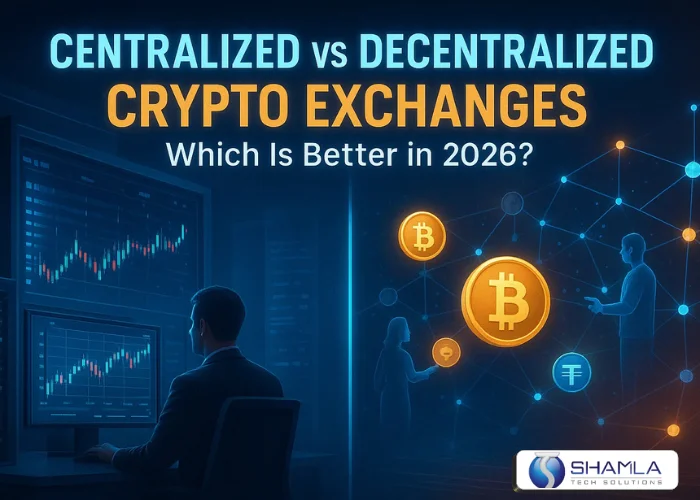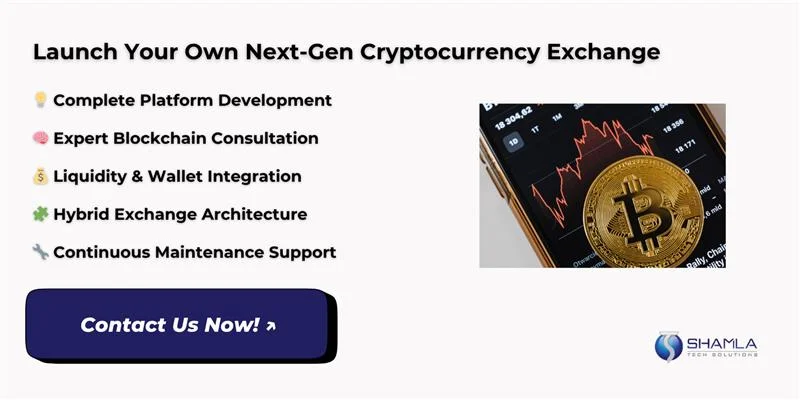In digital finance, crypto exchanges remain the backbone of trading activity and liquidity. As we move into 2026, understanding the Centralized vs Decentralized crypto exchanges debate has become crucial for investors, developers, and institutions alike.
Each crypto exchange model has to offer distinct strengths in accessibility, transparency, and control, which is shaping how digital assets are being exchanged and secured. With growing innovation in blockchain and smart contract infrastructure, it’s vital to recognize how these platforms differ within the broader spectrum of Types of Crypto Exchanges and what that means for the future of global cryptocurrency adoption.
Centralized vs Decentralized Crypto Exchanges
Feature | Centralized Exchanges (CEX) | Decentralized Exchanges (DEX) |
Control | Managed by a single company or entity | Controlled by users through smart contracts |
Custody | Platform holds user funds in its wallets | Users hold their own funds in private wallets |
Speed | Faster transactions due to internal order matching | Slower transactions depending on blockchain speed |
Liquidity | Higher liquidity as centralized systems pool users | Lower liquidity as trades depend on active users |
Security | Exposed to hacks and breaches due to central storage | Safer against hacks but depends on smart contract quality |
KYC/AML | Requires full user verification | Often allows anonymous trading |
Fees | Usually higher with trading and withdrawal fees | Lower fees but higher gas costs during network congestion |
What are Centralized Crypto Exchanges?
Centralized exchanges are trading platforms managed by a company that oversees all operations, including order matching, user verification, and fund management. These platforms store user funds in their own wallets, allowing faster trade execution and higher liquidity.
Users trust the exchange to secure assets and maintain uptime, similar to how banks manage money. Centralized exchanges like Binance or Coinbase use strong security systems such as multi-signature wallets, cold storage, and compliance checks. They are preferred for traders who need fast execution, margin trading, and customer support.
However, their main weakness is the risk of data leaks or hacks, which makes Security in Cryptocurrency Exchanges a key concern for developers and regulators working on better infrastructure.
What are Decentralized Crypto Exchanges?
Decentralized exchanges work through blockchain-based smart contracts that allow users to trade directly from their wallets without depending on a third party. This system removes the need for account verification and gives users full control of their funds.
Trades are verified on the blockchain, creating a trustless system where ownership always stays with the user. DEXs like Uniswap and PancakeSwap operate using liquidity pools, where users provide tokens for others to trade. Although transaction speed and liquidity are lower than centralized options, DEXs offer higher transparency and privacy. They also reduce single points of failure, which makes them more resilient to shutdowns.
This model highlights the real differences between CEX and DEX and helps in a clear CEX vs DEX comparison, showing how decentralization improves fairness and control. These factors are central to Crypto exchange types explained across modern trading platforms.
When or Why to Choose a Centralized Exchange (CEX)
High Liquidity And Fast Execution
Centralized exchanges offer deep liquidity and fast order matching that suit active traders and institutions. Order books pool buy and sell interest so large orders fill without big price moves. Matching engines run off-chain or in optimized systems to cut delay and raise throughput, so trades settle quickly for users.
For many traders these factors are core Centralized crypto exchange advantages when speed and predictable pricing matter. In practical Centralized vs Decentralized crypto exchanges terms, centralized platforms win on market depth and execution. Operators focus on uptime, replicated databases, and low-latency networks to keep systems steady for heavy trading.
User Experience And Support
Centralized platforms give clear account flows, fast deposits, and dedicated support, which lowers barriers for new users. Fiat rails, card onramps, and verified wallets make getting started simple, so beginners can trade without managing keys. Customer service teams and dispute tools help with fee issues, account recovery, and compliance checks, which many retail traders value.
These practical points are important Centralized crypto exchange advantages that attract mainstream customers. In the CEX vs DEX comparison, user experience and support push choices toward centralized systems for firms that need predictable service levels and clear legal standing to meet regulator demands and uptime.
Advanced Trading Features And Scalability
Professional traders use margin, derivatives, and algorithmic APIs that centralized systems support with low delay. Risk engines, leverage limits, and custodian links let firms manage large positions while keeping user funds ready for quick settlement. These built-in tools are key Centralized crypto exchange advantages for market makers and trading desks.
When teams build a Scalable Cryptocurrency Exchange Platform they choose microservices and caching layers to handle load spikes. Smart architecture in Centralized Crypto Exchange Development lowers downtime and raises throughput. For businesses that need high trade volume and advanced products, centralized systems remain the practical choice because tooling is mature.
Building And Compliance Considerations
Companies that want to Create A Cryptocurrency Exchange often pick centralized models for clear rules, bank links, and native fiat support. Building a platform needs secure custody, KYC flows, and legal checks to meet laws in each market. Teams also must Develop a Secure Crypto Exchange with hardened key storage, layered access controls, and routine code checks to avoid breaches.
Centralized designs let operators patch bugs and update services quickly, which helps keep users safe. For founders seeking fast market entry and clear governance, a central system reduces legal and operational friction while giving a path to scale and partnerships.
When or Why to Choose a Decentralized Exchange (DEX)
Clear Ownership And Private Keys
Decentralized platforms give users full control of their funds via private wallets and keys. This means no company can freeze or move assets without the owner’s permission. One major Decentralized exchange benefit is on-chain settlement that keeps a public record of transfers and reduces hidden ledgers.
This setup lowers the risk of sudden access loss and avoids a single point of failure. When comparing models, the Centralized vs Decentralized crypto exchanges choice shifts trust from firms to open code. Developers and users who want custody and clear audit trails prefer this model today.
Permissionless Trading And Open Access
DEXs let anyone trade without long signup forms or identity checks, lowering entry barriers for global users. Automated market makers and on-chain order books allow continuous liquidity and simple programmatic swaps. In a clear CEX vs DEX comparison, DEXs let developers list tokens quickly and let small traders access new markets without permission.
Decentralized exchange benefits also include composability with wallets and other protocols, enabling users to build trade flows with simple contracts. This model suits builders and traders who want open access, rapid token listing, and the ability to combine tools without corporate approval.
Transparency And Code-Driven Rules
Every trade and liquidity change on DEXs is visible on public chains, so volumes and fees can be verified by anyone. This openness removes hidden ledgers and gives clear proof of activity, which helps auditors and users. These transparency features show the Differences between CEX and DEX in audit trails and dispute handling.
Liquidity providers can see exact fee splits and smart contract rules, which cuts guesswork about where funds move. Users still must secure private keys and watch for buggy contracts, but projects that need open records favor this model for auditability and records.
Resilience, Innovation, And Hybrid Paths
Decentralized networks avoid a single point of failure because nodes and contracts share work across many machines. This design improves uptime and lowers the chance that one breach stops service, which matters for Security in Cryptocurrency Exchanges planning.
DEXs also enable rapid feature tests, like new liquidity programs or farming incentives, pushing innovation faster than slow corporate cycles. For teams seeking both speed and control, plans to Launch Hybrid Crypto Exchange combine on-chain settlement with optional custody layers. Some firms aim to build a Bybit-like Crypto Exchange Platform pairing order tools with on-chain settlement today.
Choosing the Right Model for 2026: Centralized vs Decentralized Crypto Exchanges
1. Operational Trade-offs
Assess core trade-offs when you review Centralized vs Decentralized crypto exchanges. Centralized systems give fast matching, pooled liquidity, fiat rails, and clear service teams. Decentralized designs give user custody, on-chain proof, and code-run rules that avoid a single point of failure.
Knowing Types of Crypto Exchanges helps builders set risk rules and user flows. In short, choose central models for speed and deep markets, and choose decentralized models when custody and public checks matter. Teams must weigh custody risk carefully.
2. Hybrid And Modular Architectures
Adopt hybrid stacks to mix custody and on-chain settlement. Teams can Launch Hybrid Crypto Exchange models where order books run off-chain while final settlement occurs on chain. This pattern solves the CEX vs DEX comparison by offering fast fills plus user control.
Modular services let teams swap custody or matching layers without rebuilding core logic. For product owners, modular design cuts time to market and gives clear upgrade paths while keeping on-chain proof and fiat links.
3. Security And Compliance
Build layered controls to Develop a Secure Crypto Exchange that keeps keys safe and limits damage from breaches. Use hardware key stores, signed multi-approvals, and routine safety tests. Add clear KYC gates and transaction limits so rules meet local laws.
Security teams should log events to public or private ledgers for audits. Trusted patches and fast incident steps matter more than novel tools. Strong, simple controls reduce risk and keep user trust high across platforms. Keep simple runbooks and drills.
4. Scalability And Performance
5. Choosing Crypto ExchangeDevelopment Partners
Conclusion
The ongoing Centralized vs Decentralized crypto exchanges debate will shape how traders interact and how platforms evolve in 2026. Each model serves unique goals – centralized for speed and liquidity, decentralized for transparency and control. The future lies in secure, scalable platforms built to Develop a Secure Crypto Exchange with flexibility and trust.
Shamla Tech is a leading cryptocurrency exchange development company that helps businesses design both centralized and decentralized platforms customized to their goals. We focus on building secure, scalable, and regulation-ready systems that support smooth trading, advanced features, and strong compliance for lasting growth in the digital asset market.
Contact us today to build your secure, scalable, and future-ready crypto exchange platform!





